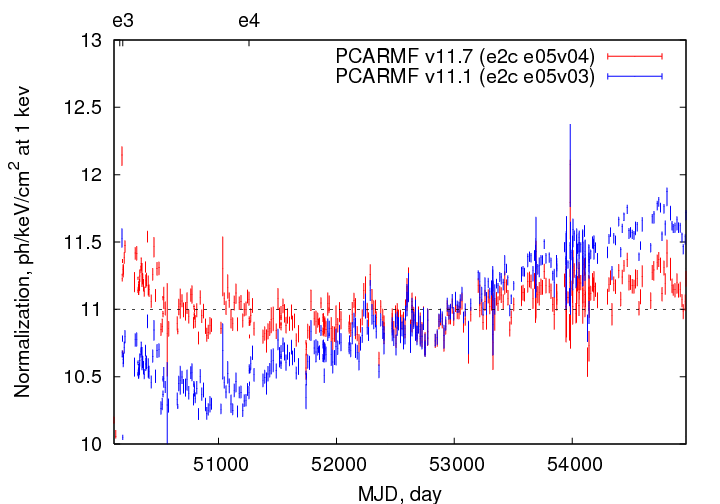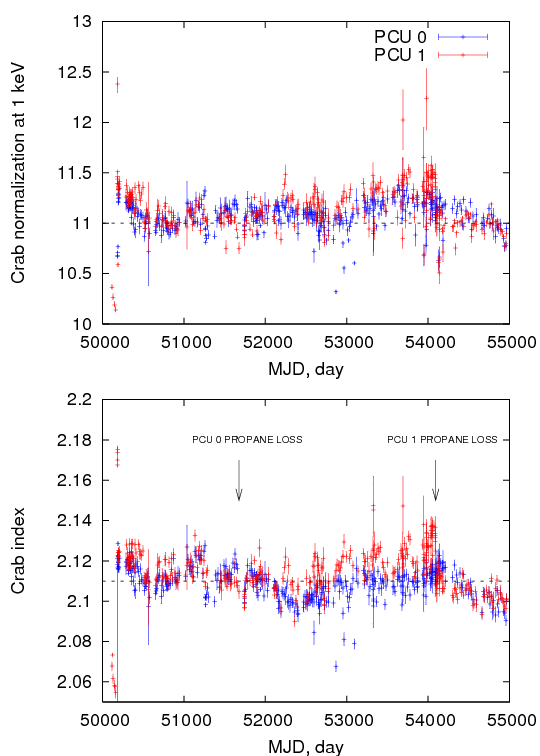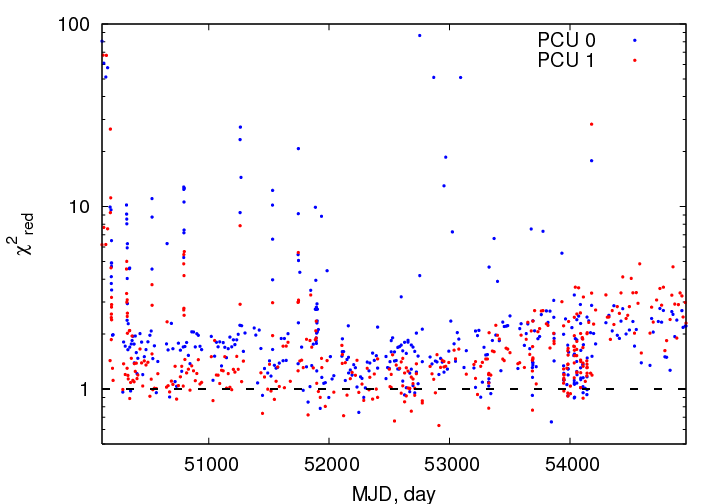|
Improvements to the PCA Response Matrix (version 11.7) Table of Contents
SummaryThis document describes the new version of the RXTE Proportional Counter Array (PCA) response generator PCARMF v11.7 (along with the corresponding energy-to-channel conversion table e05v04) and its difference with respect to previous versions of the program. These results represent the product of a new and improved technique to model calibration data. The new PCA response adequately represents the spectrum of the calibration sources and successfully predicts the energy of the narrow iron emission line in Cas-A, and provides a significant improvement for calibration quality throughout the RXTE mission. The change is particularly strong for data taken after the year 2004 (the time of the last energy-to-channel update), although there is at least some improvement for observations taken throughout the mission. While RXTE users are not expected to modify their scripts, they should be aware of these changes in the response behavior. PCARMF v11.7 shows significantly better performance with respect to any previous version and is highly recommended for use to get most consistent results. The PCA team makes the following recommendations for observers with PCA spectral data:
Where to Download: IntroductionOver the past several years, especially since 2004, guest observers and the PCA team have noted a poor quality of the Crab spectral fit and the energy scale behavior, and gradual worsening behavior. This report details the strategy used to improve the quality of PCA spectral modeling, and the results. For spectral analysis of PCA data with modeling tools like XSPEC, one must compute a response matrix. Response matrix files calculation for PCA data is done with the PCARMF software tool (as well as the PCARSP tool, which is a "wrapper" around PCARMF). The PCARMF tool consists of the several major components: the quantum efficiency (i.e. effective area), the redistribution matrix (i.e. the spectral resolution), and the energy to channel relationship (i.e. the gain). The behaviors of these components are controlled by various parameters. The quantum efficiency and redistribution parameters are stored in the task parameter file pcarmf.par. The energy-to-channel relationship is described by coefficients in a table which resides in calibration database CALDB, the so-called "e2c" file (which can alternatively can be a stand-alone FITS or ASCII file). This general design has not changed from previous PCARMF versions. The new version of the PCA response (version 11.7) uses the same tye of parameters and assumes the same structure of the e2c file. Hence, the new tool should behave the same way as previous versions and no modification in the program usage (i.e. in scripts) should be necessary. The energy to channel relation is determined by various calibration-type observations. The PCA instrument has a radioactive Am241 calibration source which produces spectrum with fixed-energy lines. Also, observations of the supernova remnant Cas A and the Crab were used to tie the low energy to channel relation and overall response. ImprovementsFor the new version of the PCA calibration, improved performance is achieved using different response residuals minimization approach (see the next section). Close examination of the e2c conversion table led to considerable revision of epoch treatment and new coefficient settings (see details below). Also, the non-linear time dependent coefficients are set to zero for a new e2c table. The cubic energy term in the e2c scale, which was set to zero in previous versions, was utilized and proved to be non-zero. Another area where PCARMF v11.7 differs significantly from the previous version is treatment of xenon L-escape lines. While L-escape contribution for the layer 1 is indeed negligible, this is not true for layers 2 and 3. This discrepancy can be explained as a fraction of L-escape photons which emerge from one layer and are detected in a different layer. In fact, these L-escape contributions from layer 1 are large and could be seen by eye in spectra of layer 2 and 3, with previous response matrix versions. This artificial feature appeared near 4~5 keV when all PCU layers were analysed together. In the PCARMF v11.7, L-escape contributions are described for each layer individually. According to expectations, the normalization for L-escape line is effectively zero for layer 1 and non-zero for layer 2 and 3. In summary, the PCARMF v11.7(+ e2c e05v04) comprises the following changes with respect to the previously released PCARMF version v11.1 (e2c e05v03):
Table 1. RXTE PCA gain interval. Intervals marked with a "Y" have new energy-to-channel values starting at that time, for the corresponding PCU (although dummy entries are present in the file for other PCUs). The above changes and modification considerably improved the performance of the response. Below we describe the minimization technique and the results in some detail. ResultsIn the Figures below the results of powerlaw spectral fits for all individual Crab observations throughout RXTE mission are shown for PCU 2. Two response versions are used, the last released v11.1 version and the new v11.7 response. No systematics was assumed. Channels 1-3 were ignored during these test fits.
The fit quality, Crab normalization and index behavior for PCUs 3 and 4 is similar to what is shown in Figures 1-3 for PCU 2. Response version v11.7 shows significantly better performance throughout the mission. Moreover, the performance of the v11.1 response becomes unacceptably bad starting on 2004 and gradually worsening thereafter. The new response shows consistent description of the Crab spectrum with much lesser trends than for the previous version and excellent uniform statistical performance. Technically speaking the upgrade from v11.1 to v11.7 in analysis will affect observations throughout the mission including observations from epochs 1 and 2. However, as it is shown in Figure 3, the most dramatic changes occurred for observations starting around 2004, when the last update to e2c relationship was made. One area where PCARMF v11.7 differs significantly from v11.1 is treatment of xenon L-escape lines. In the previous response version L-escape lines were ignored. While L-escape contribution for the layer 1 is indeed negligible, this is not true for layers 2 and 3. This can be explained by the fact that most photons with energies near L-edge (~5 keV) are absorbed in the layer 1 and most of L-escape photons produced in this layer are vetoed by the electronics. However, a small fraction of L-escape photons in layer 1 do not get absorbed in the same layer and therefore are not vetoed. Some fractions of this unvetoed photons are detected in layers 2 and 3. For these layers contributions from these photons are not small. In fact, these L-escape contributions from layer 1 are large and can be seen by eye in spectra of layer 2 and 3. These significant contributions were not accounted for in previous calibration versions. It led to an artificial feature at about 4~5 keV, when all PCU layers were analysed together. In the PCARMF v11.7 The L-escape contributions are described for each layer individually. According to expectations, the normalization for L-escape line is effectively zero for layer 1 and non-zero for layer 2 and 3. Response of PCU0 and PCU1PCUs 0 and 1 have lost their propane layer, presumably due to amicrometeorite hit. This resulted in a gain shift, which required an additional e2c epoch for these PCUs introduced after the propane loss event. In addition, the increased particle flux resulted in higher contamination and higher systematics. Figures below show the Crab index, normalization and fit statistics for PCUs 0-1.
The calibration for PCUs 0 and 1 is slightly worse than for PCUs 2-4. However the data for PCUs 0-1 is usable for scientific analysis with the new response. This is particularly important for the spectral analysis of the high resolution PCA data modes (i.e. Burst Catcher and Event Modes) where counts from all active PCUs are mixed together. Mixing Software and CALDB VersionThe PCA team recommends to use matching versions of the PCARMF software and CALDB energy to channel files. The correct versions are:
Using matching versions, users will obtain the greatest benefit of the changes described in this report. It is possible - although not recommended - for users to mix old software and new calibration file, or new software and old calibration file. Doing so will provide improved performance over using the older versions of both, but not the maximum benefit. Thus, using mixed software and CALDB files will not be a fatal flaw in ones scientific analysis. Still, the PCA team recommends to update both software and calibration at the same time. Not only does this provide the best spectral improvement, but it assists the scientist in documenting their results for publication. How to Use the New Response MatrixThe new response matrix is a combination of software and calibration files. In order to get the full benefit of the new response matrix, users should download new versions of the software and a new version of the PCA CALDB, released after 2009-08-17 (see above for download details). The new version of the PCARMF software works in the same manner as previous versions. There are no new command line options. However, several calibration values used by PCARMF are stored in the task parameter file. HEASOFT keeps a 'system' copy of this file, and also a local cached copy of the parameter file which is stored as 'pcarmf.par' in your home parameter file directory (usually $HOME/pfiles). To make sure you have the newest parameters, type the following command: punlearn pcarmf This should erase any old, locally cached values and load the newest system values. The response matrix changes apply to observations taken throughout the RXTE mission, i.e. the response matrix will be improved for all observation dates. However, the greatest improvement will be for observations taken after the year 2004, as shown in the figures above. Systematic ErrorsWhen analyzing PCA spectra, the PCA team recommends to use a systematic error of 0.5%. This is accomplished within XSPEC by using the syst 0.005 command. Lower Energy LimitThe PCA calibration is not accurate for Standard2 channels 1-3, so the PCA team recommends to use the XSPEC command ignore 1-3 in order to ignore those channels in Standard2 data. Upper Energy LimitThere is significant PCA response up to about 70 keV, but the response is poorly calibrated above 50 keV. Tests using several bright or spectrally hard galactic sources (i.e. several Crab sources and/or black hole binaries) indicate the presence of artificial systematics above 50 keV. These features may be related to insufficient knowledge of the Crab spectral shape, insufficient calibration data, poor representation of the energy-to-channel or background correction above this energy. While the issue will be further investigated by the RXTE team, the energy range above 50 keV is currently not recommended for detailed scientific analysis. For softer sources, the upper energy bin should be determined by the energy at which the source becomes undetectable by the PCA. Detailed Calibration Analysis MethodsFor the previous versions parameters were calculated by fitting the individual Crab spectra and then averaging the results. Parameters for PCARMF v11.7 are calculated for each PCU unit by fitting a set of Crab "calibration" observations and a set of Americium 241 data simultaneously covering whole RXTE mission span. This approach proved to be much more effective in finding the best-fit set of parameters for quantum efficiency, redistribution and e2c table simultaneously. PCARMF parameters were fitted in XSPEC using the pcarmf XSPEC model, which is essentially a replica of PCARMF code as a local XSPEC model. The parameters of the model are
The data set for each response fitting session consisted of the number of Crab and Am241 spectra all covering entire RXTE mission span. Individual PCARMF model is assigned for each spectrum. CRAB power law index and norm are linked for all data sets and e2c coefficients are linked for all spectra from the same epoch. The parameters of PCARMF and e2c coefficients are optimized to obtain a minimum of Chi-statistic. Crab spectrum is assumed to have photon index of 2.11 and the normalization of 11.0 and absorbed by N_H=0.334. Response is calibrated for channels above 3 (in Standard2 channel numbering). Therefore, when fitting PCA spectrum in XSPEC it is recommended to use "ignore 1-3" instead of "ignore **-3.0" (i.e. ignore in channels space instead of energy domain). ConclusionThe new PCA response (PCARMF v11.7, e2c e05v04) presents a significant improvement in quality of the calibration data representation. RXTE data users are strongly encouraged to update the RXTE FTOOLs package to download latest release of PCARMF response generator (by updating FTOOLS package) and the corresponding RXTE energy-to-channel relashinship (by updating CALDB) to get the best RXTE calibration. Changes
If you have a question about RXTE, please send email to one of our help desks.
|






